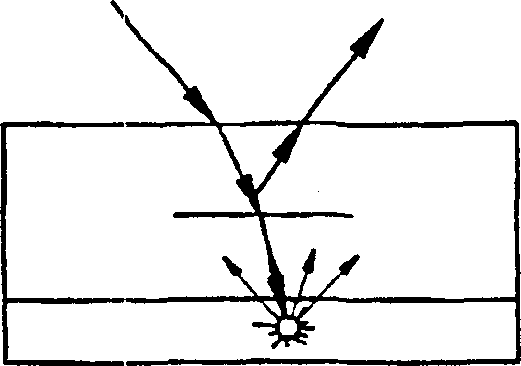Methods for manufacturing silver multilayered films and the articles obtained therefrom
A multi-layer film and silver technology, applied in layered products, chemical instruments and methods, natural mineral layered products, etc., can solve problems such as high coating production costs, high investment costs, and environmental problems
- Summary
- Abstract
- Description
- Claims
- Application Information
AI Technical Summary
Problems solved by technology
Method used
Image
Examples
Embodiment 2
[0122] In this example, the aluminum flakes of Example 1 were "reinforced" by coating them with a transparent ceramic (such as silica or alumina) so that they were hard enough to maintain their aspect ratio during melt processing. Reinforced flakes are commercially available from Flex Products Inc. and coated by vacuum deposition. These reinforced aluminum flakes were run in polycarbonate in the same manner as in Comparative Example 1. Brightness (L * ) and change in brightness as a function of viewing angle (ΔL * ) are shown in Fig. 7(a) and (b) respectively. In Figures 7(a) and (b), it can be seen that the behavior of the reinforced alumina mimics that of the silver-painted specimens more closely than the unreinforced aluminum flakes used in Example 1. Figure 8(a) and (b) are transmission electron micrographs showing that the reinforced aluminum flakes did not suffer the same damage as the unreinforced aluminum flakes.
Embodiment 3
[0124] In this example, 5.4 wt% mica flakes, 0.6 wt% aluminum flakes, 0.01 wt% carbon black coated with titanium dioxide were added to the middle layer instead of the aluminum flakes. All three layers, that is to say the inner layer, the middle layer and the second layer, are made of polycarbonate. The three layers were coextruded in a similar manner to Example 1. The first layer of this example contained 1 wt% mica flakes coated with titanium dioxide and 0.01 wt% carbon black.
[0125] Brightness (L * ) and brightness change as a function of viewing angle (ΔL * ) are given in Fig. 9(a) and (b) respectively. From these curves, it can be seen that the samples containing TiO-enhanced mica give brightness (L * ) and brightness change as a function of viewing angle (ΔL * ), which is closer to silver paint than unreinforced aluminum flakes. This again demonstrates that the retention of the aspect ratio and the resulting orientation of the flakes in the interlayer facilitates ...
Embodiment 4
[0128] In this example, an intermediate layer containing 1 wt% of mica flakes coated with titanium dioxide was placed over the first layer, which also contained mica flakes coated with titanium dioxide. Both layers contained a small amount of about 0.001 wt% carbon black, where wt% is based on the total weight of the layer. Since the titanium dioxide-coated flakes in the interlayer allow a substantial amount of incident light to pass through the interlayer, it is generally desirable to minimize the amount of transmitted light and maximize the amount of reflected light. One possible way to achieve this is to apply a first layer that promotes an increase in the amount of reflected light based on the incident light on the film. To facilitate increased reflection of incident light, the first layer contains titanium dioxide-coated mica flakes and carbon black. Brightness (L * ) and brightness change as a function of viewing angle (ΔL * ) are given in Fig. 11(a) and (b) respectiv...
PUM
 Login to View More
Login to View More Abstract
Description
Claims
Application Information
 Login to View More
Login to View More - R&D
- Intellectual Property
- Life Sciences
- Materials
- Tech Scout
- Unparalleled Data Quality
- Higher Quality Content
- 60% Fewer Hallucinations
Browse by: Latest US Patents, China's latest patents, Technical Efficacy Thesaurus, Application Domain, Technology Topic, Popular Technical Reports.
© 2025 PatSnap. All rights reserved.Legal|Privacy policy|Modern Slavery Act Transparency Statement|Sitemap|About US| Contact US: help@patsnap.com



